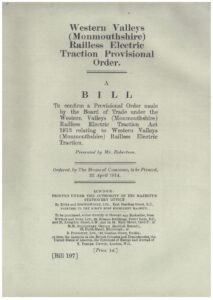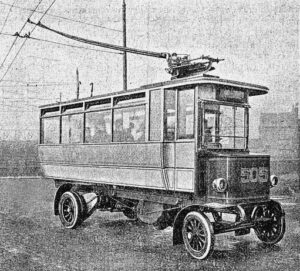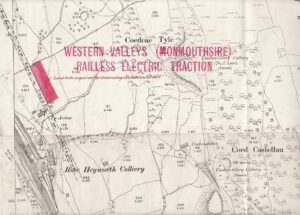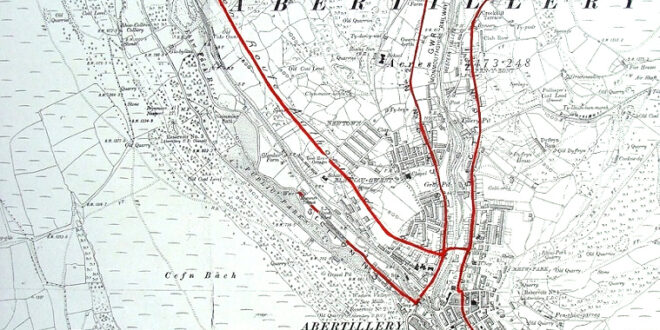The Western Valley’s Railless Traction Trolley Bus Scheme.
The Railless Traction Trolley Bus Scheme was the introduction of a bus service with the vehicles powered by electricity through the means of overhead electric wire system. Other than the electric power, the buses were normal transport vehicles with rubber tyres. Each bus had an overhead hanger cradle incorporated to ensure a continuous contact with the power lines which were to be installed along the streets which would power the vehicle all along its route.
 The idea of this new transportation service was first proposed in 1910. In a report from January 1911, it was stated that in the next session of Parliament a bill would be introduced and been deposited for the incorporating and conferring powers on the Western Valley’s (Monmouthshire) Railless Traction Company. The Bill would establish the railless traction in other centres. The preamble of the Bill stated the running of trolley buses moved by electrical power transmitted from an external source, for the conveyance of passengers, animals and goods along the routes described, would be of the public and local advantages and therefore expedient that a company should be incorporated for that purpose.
The idea of this new transportation service was first proposed in 1910. In a report from January 1911, it was stated that in the next session of Parliament a bill would be introduced and been deposited for the incorporating and conferring powers on the Western Valley’s (Monmouthshire) Railless Traction Company. The Bill would establish the railless traction in other centres. The preamble of the Bill stated the running of trolley buses moved by electrical power transmitted from an external source, for the conveyance of passengers, animals and goods along the routes described, would be of the public and local advantages and therefore expedient that a company should be incorporated for that purpose.
In accordance with the recital the Bill proposes to incorporate Sir James de Hoghton; Mr Francis Watson Smyth and Other persons who shall thereafter be proprietors in the undertaking. The company would be known as “The Western Valley’s (Monmouthshire) Railless Traction Company”. The capital of the company was £60,000 in 10,000 shares of £1 each with the power to raise a further sum of £20,000 by the issue of debenture stock. The company directors were the first two gentlemen named.
 The Abertillery Section Route.
The Abertillery Section Route.
The company asked for powers to provide and work trolley vehicles, (similar to the one in the image featured right) by electricity along a route from Brynmawr to Newport. The Abertillery Section route was as follows –
Route 1 – Six Bells (Post Office) – up Alexander Road – Somerset Street – Church Street – Tillery Street – Tillery Road and up to the Woodland Brick Works and back to the Foundry Bridge:
Route 2 – Across the Foundry Bridge – Alma Street – Gwern Berthi Road to Cwmtillery Colliery and back to the Foundry Bridge:
Route 3 – Down Station Hill – Carlyle Street – Glandwr Street and to the Park Entrance and back to the Foundry Bridge:
Route 4 – Gladstone Street – Rose Heyworth Road and up to the Tilers Arms:
 The Electrical Generating Station.
The Electrical Generating Station.
On this latter section a large electrical generating station was planned to be built on land opposite the Rose Heyworth Colliery (close to where the bottom Arael View housing estate is today – as seen coloured red on the map) The Aberbeeg Six Bells section would have been powered by an electrical generating station at Aberbeeg Junction.
The maps featured are the actual maps of the route issued by the company.
The Aberystruth section commenced at the southern end of the Market Place at Brynmawr and passing along the main road from Brynmawr to Aberbeeg junction, through the parishes of Aberystruth, Abertillery and Llanhilleth and terminating on the roadway at Aberbeeg Junction Station.
In February 1911 the Risca Council was approached and asked to promote and support the Railless Traction Scheme up through the valley.
In March 1911 at the Abertillery Rate Payers Association meeting held at the Waverley Hotel Abertillery, the secretary read out a letter by Mr G. Bishop of Brynmawr, acting on behalf of the Railless Company, in which the association was asked to support the Bill in Parliament. A vote followed and on the count of eight to five votes for the request was agreed.
In October 1911 the Mynyddislwyn District Council was approached and asked to promote and support the Railless Traction Scheme up through the valley. At this meeting it was proposed to send representatives to Leeds and Bradford to inspect similar undertakings. Mr D. J. Treasure said it was ridiculous to compare such populous centres with that district. Mr J. Boothman moved that owing to demands on their finances the council declined on sending representatives. It was noted that they either voted to go ahead and support the scheme or withdraw from it. They opted to send one representative and see how the scheme develops
On Monday 10th of June 1912, the Abertillery Council heard that joint district council meetings were to be held with the engineer of the scheme, Councillor Mr Boots said there would be no opposition from the Rate Payers Association and Mr Downs said there would be no fear from and opposition from the Great Western Railway Company as they refused to give a service to the populous parts of the district. Mr Davis from Six Bells also supported the motion.
On Wednesday 10th of July 1912, a conference of the representatives of the local authorities was held at Abertillery. Mr Sellon engineer of the scheme and Mr F. J. Matthews of Abercarn presiding to further consider the proposal of the Traction Trolley Bus Scheme in the Western Valley’s. Mr T. S. Edwards was present from the Abercarn Council. Letters were read out from Nantyglo and Blaina Council asking for the meeting to be convened. The meeting was convened until a later date. More meetings took place in Abercarn and it was stated that the real movers in the implementation of this scheme was Nantyglo and Blaina though many were against as of the lack of good roads either too narrow or too hilly and steep. The engineer stated the route would be 15 miles through the valleys and would require power stations on the route to generate the electricity.
On Friday 19th of July 1912, the Nantyglo and Blaina District Council held a meeting in the Blaina Gymnasium to approve the Traction Scheme for the Western Valley. Councillors Mr G. Price (Chairman); Mr W. Parry; Mr G. H. Jenkins (Finance); Mr J. Manning; Mr W. Williams; Mr D. Minton; Mr W. Meyrick; Mr D. J. Thomas; Mr J. W. Parry and Mr C. W. Edwards attended. Mr Cummings moved the scheme should not be entertained at present with Mr E. Sainsbury seconding.
Over the next few months, the councillors became less enthusiastic about the service and the voting on the matter became tight and unclear as to what was to happen next. Nantyglo and Blaina waited upon Abertillery, the Abertillery councillors wanted the electorate to vote on it and everyone was sitting on the fence. In the meantime, the council held meetings with the Great Western Railway Company to put pressure on them to build railway stations at Six Bells and Cwmtillery but the company declined so the Abertillery District Council arranged for a public meeting at the Powell’s Tillery Institute to gauge the electorates feeling towards the Railless Traction Scheme.
On Tuesday 1st of October 1912, the public meeting was held at the Powell’s Tillery Institute, Abertillery under the auspices of the Abertillery District Council and the Central Ward to express an opinion with regard to the proposal that council join the Nantyglo and Blaina and Abercarn in the “Joint-Railless Traction Trolley Bus Scheme”. The crowd were told of the representatives reports on the similar scheme in Yorkshire, Bradford and Leeds, where the construction went well and a profit was made on the service. They said it would be a benefit to these valleys. The following councillors expressed their opinions – Mr J. Emlyn Phillips; Mr Parfitt; Alderman W. Thomas J.P.; Mr Gill; Mr A. J. Cottle; Mr W. Jones and Mr W. Spencer, practically all against the scheme. Later the amendment was modified in favour of the Abertillery District Council deferring the matter for 12 months and it was carried by 24 votes to 15 votes.
On Monday 23rd of June 1913, the Western Valley’s Railless Traction Trolley Bus Scheme Bill came before the Select Committee in the House of Commons. Mr J. J. Clatsey, presided. Those present included Mr Vasey Knox; Mr W. Szlumper; Mr Wedderburn K.C.; Mr John Raikes (Monmouthshire County Council); Mr Rhys Williams (Breconshire County Council); Mr Talbot K.C.; Mr H. Beveridge (Lancaster Steam Coal Company); Mr William Barrow Harrison; Sir James de Hoghton; Sir Alexander Gibbons and Mr George Julian Polglase (Director of the Railless Traction Construction Company):
The Unsatisfactory Road Conditions.
During the hearing many arguments were heard for and against the scheme, engineers told of the obstacles which had to be overcome, the lack of width on the roads on the routes, the steepness of the hills etc. The engineer told of the narrow section on Lower Gladstone Street and the town centre streets, also the steepness on High Street Llanhilleth and the high embankments on the same road while travelling north with the drop on the left side. There were also objections raised by the Lancaster Steam Coal Company with the proposed high voltage power stations which was planned to be built close to their Rose Heyworth Colliery and the colliery they were planning at Aberbeeg. They explained that they were concerned over the unknown effects such power stations would have on their mining equipment and possible effects on the workings as to their close proximity to their collieries. The committee was told the route would be 20 miles in extent from Brynmawr to Newport.
The Colliery Owners Opposition.
In July 1913 it was announced that the J. Lancaster Steam Coal Collieries Ltd were opposing the Western Valley’s (Monmouthshire) Railless Traction scheme in the Lords. This Bill had passed through the Commons.
The Later Years.
I cannot find any later reports in connection to this scheme. The Great War broke out soon after and this project was shelved, never mentioned again.
 Out Of The Blue Artifacts A Library of a lifetime of collecting
Out Of The Blue Artifacts A Library of a lifetime of collecting
